
Stone Carving Tutorials
Stone Carving Tools
At the most basic level, you can carve stone with just a hammer and point chisel. But having a variety of the proper tools, of good quality, will make the work easier and more enjoyable. Here is a sample of some of the tools used for stone carving.
(Note: The Sculpture Studio does not sell tools. See links below for tool catalogs.)
Hand Tools
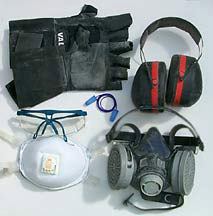
Safety Equipment
The most important safety rule is to always wear safety glasses. Wearing a respirator is advised when working around stone dust, and is absolutely required when working with stones containing silica (like granite) or other toxic materials.
Ear protection should be worn when using pneumatic tools and diamond saws. Shock resistant gloves protect hands from the pneumatic tool vibration and abrasions from sharp stone chips.
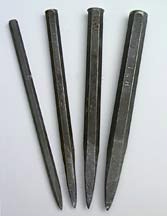
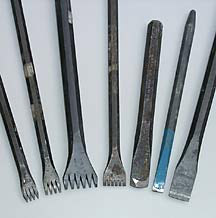
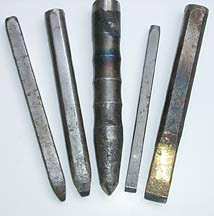
Chisels
The point chisel or punch is the workhorse of the chisels. It is used for roughing out and removing material quickly.
The ones shown here are hardened steel which work well on softer stones and marble. For harder stones like granite, carbide tipped chisels are required.
On soft stone, the point chisel can leave a 'stone bruise', or white mark, when it has gone deeper into the stone than your intended surface. Care must be taken not to 'bury' the chisel into the stone. These unintended white marks will show up when the stone is polished.
These bruises can only be removed by carving or filing down into the stone past the depth of the bruise.
The tooth chisel is used after the point chisel has roughed out the basic shape. It further refines the forms and removes the peaks and valleys left by the point chisel.
The flat and rondel chisels come into play for smoothing out the texture left by the tooth chisel and prepares the stone for finishing. Any stone bruises left by the point or tooth chisels can be removed with a flat chisel or a riffler file.
Hand tools for harder stones, like granite or sandstone, must be carbide tipped. The three tools on the left are point chisels. The two on the right are flats.
In the center is a point chisel made in the Japanese style, with a round piece of carbide in the center of the tool, like a pencil. While carbide is a very hard metal, it is also very brittle and can be chipped if stuck against the stone incorrectly. Carbide can be sharpened with a green stone on a table grinder. Unlike steel, carbide should never be quenched, since the quick cooling could cause it to shatter.
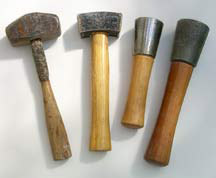
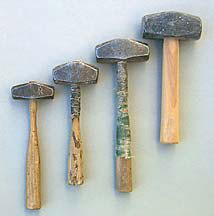
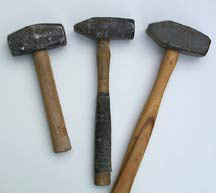
Hammers
Hammers come in a variety of weights for doing different jobs. The small 1 pound hammer is used for carving small details. The 1 1/2 pound hammer is good for general carving.
The hammer on the far left is designed for use on granite and has a hardened steel head. It is used with chisels with untempered ends and will cause the chisel to mushroom over. To the right of it is a lump hammer with a soft steel head. It can be used with chisels that have tempered ends, and in this combination, the hammer head will mushroom over. Never use a hardened hammer with a hardened steel chisel end. Striking too hard with this combination could cause metal fragments to fly off the end of the chisel like shrapnel.
The 3 pound hammer has sufficient weight to effectively drive a point chisel or pitching tool in removing large chunks of stone. The 'rock buster' on the right has a carbide edge which can be placed on the edge of a stone, similar to a pitching tool, and struck with another hammer to bust off large chunks of stone.
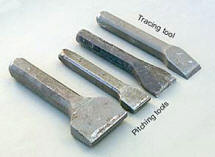
Handset
The handset or pitching tool is used for knocking large chunks of stone off the edge of a square block. It can be very effective in removing a lot of stone quickly.
The tracing tool is used for creating a more precise line along the edge of a block.
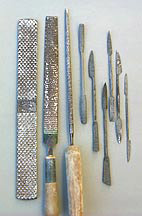
Rasps and Rifflers
The final shaping of the softer stones can be done with rasps. Power tools for finishing can sometimes be hard to control and give a mechanical look. The use of rasps provides a more natural, flowing finish. The rasp's scratch marks can be left as a textural element, or removed with sandpaper.
Sand Paper
Usually the last thing to work the stone is wet/dry Silicone Carbide sandpaper. Grits run from coarse (40-80 grit), medium (150, 220, 320 grit), to fine (400, 600, 800, 1,500 grit). Water is applied over the stone while sanding to remove the sheared-off dust particles.
Marble begins to show a polish at about 600 grit. Granite doesn't polish until 3,000 grit.
Pneumatic Stone Carving Tools
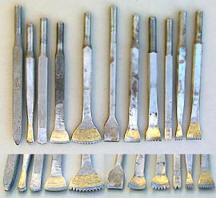
Chisels
The chisels used with pneumatic hammers are basically the same as the hand tools. The difference is the round shank (usually 1/2") that goes into the pneumatic hammer. The chisel types include: point, tooth, rondel, gouge, and flat. They can be either all steel or, as in this case, carbide tipped.
Carbide is much harder (and more brittle) than tempered steel, so it will keep an edge much longer. A carbide chisel is sharpened with a green wheel on a grinder, and is never quenched.
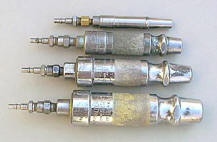
Pneumatic Hammers
These pneumatic hammers (from Trow and Holden) work on an internal piston driven by compressed air. They impart many rapid strikes per second. Hammers come in varying sizes from the pen size (like the Barre Bantum), 1/2", 3/4",1", and 1 1/4".
The 3/4" and 1" hammers are used for general carving. The more powerful 1 1/4" hammer is used for heavy material removal.
With continuous use, the constant vibration of the hammer can cause numbness in the hands. Anti-vibration gloves with padded palms reduce this impact.
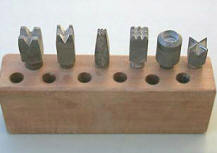
Bushing Tools
There are also specialty tools such as bushing chisels, frosting chisels, cup chisel, and criss-cross chisel.
The 4 point and 9 point bushing tools are used to pulverize granite crystals when doing the final shaping of the stone. The criss-cross tool can create interesting textures. The cup tool is used for shaping concave surfaces. The frosting tool is used for texturing marble.
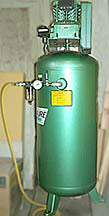
Compressor
Each size hammer requires a particular amount of air consumption to work properly. A 5 HP compressor with a 60 gallon tank should provide enough air pressure to easily run the 3/4" hammer. The 1" hammer keeps my 5HP compressor running continuously.
Use a 3/8" hose to provide an adequate air flow. A stopcock on the hose near the hammer is used to regulate the air flow. Quick connect attachments allow you to easily remove the hammers form the hose.
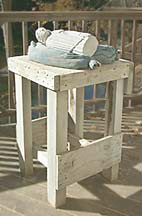
Banker
The banker, or work bench, should be strong enough to hold the weight of the stone and be stable enough to take the abuse of the pushing and pounding of stone carving.
Sand bags can be made from the cut off legs of an old pair of jeans, filled with sand, and tied off. Sand bags hold the work in place while you are carving and polishing.
Power Tools
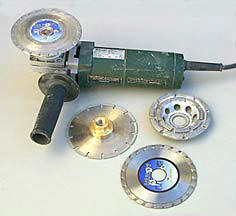
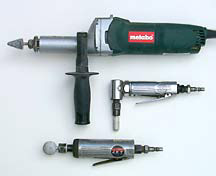
Grinder
The mini grinder with a 4 1/2" blade is an extremely useful tool for stone carving. On the softer stones, inexpensive carbide masonry cutting and grinding discs can be used.
Diamond blades are required for the harder stones like granite, but can also be used on the softer stones. A flush mount adapter increases the versatility of the tool, but will have to be used without the safety guard. You must cut in a perfectly straight line with these blades. Any torque could cause the blade to bind and kick back or damage the blade. An effective way to remove stone quickly is to make a series of parallel cuts about an inch apart, then break them off with a hammer and chisel.
The diamond cup wheel is very effective at smoothing rough surfaces on granite before polishing.
Die GrinderA die grinder can be useful when carving softer stones like soapstone and alabaster. Equipped with diamond-coated burs, it can make the job of carving small details or getting into holes and crevices much easier.
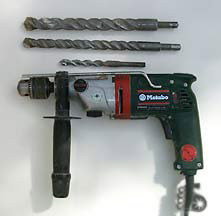
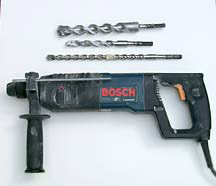
Hammer Drill
The impact 'hammer' action of a hammer drill is necessary when drilling stone. A regular drill will just spin and not cut into the stone. Carbide-tipped (masonry) drill bits must be used.
Caution must be taken when drilling a hole completely through the stone. As you near the other side, the impact of the drill will blow out the stone surrounding the exit hole.
The impact of a larger hammer drill may be required for drilling into harder stones like granite. It uses carbide tipped drill bits.
For larger holes, a pneumatic rock drill and carbide-tipped drill bits with air running down the center of the bit to the tip (to blow out the dust) are used.
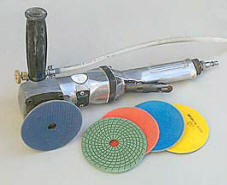
Polisher
When I polish intricate or organic shapes on softer stones, I do it by hand with wet/dry sandpaper. For polishing large, fairly flat surfaces on harder stones, I use a pneumatic, center water feed polisher.
The polisher has a Velcro head that accepts pads containing diamonds of different grits held in a hard resin, from 40 grit (coarse) to 3000 grit (very fine). The water helps wash away the dust particles removed by the diamonds.
(Note: The Sculpture Studio does not sell tools. See links below for tool catalogs.)
Stone Carving Tool Catalogs and Links
Trow & Holden Co.
PO Box 475
Barrie, VT 05641-0475
www.trowandholden.com
(Tools for marble and granite)
Gran Quartz
PO Box 33569
Decatur, GA 30033
1-800-458-6222
www.granquartz.com
(Diamond blades and adhesives for stone)
Granite City Tool Co.
PO Box 411
11 Blackwell St.
Barre, VT 05641
1-800-451-4570
http://www.granitecitytoolvt.com
(Tools for marble and granite)
The Compleat Sculptor
90 Vandam Street
NYC, NY 10013
www.sculpt.com
(Full range of tools and materials)
Sculpture House, Inc.
100 Camp Meeting Ave.
Skillman, NJ 08558
www.sculpturehouse.com
(Full range of tools and materials)
Stone for Carving
Types of Stone for Carving.
How to Carve Stone
Techniques for Carving Stone.